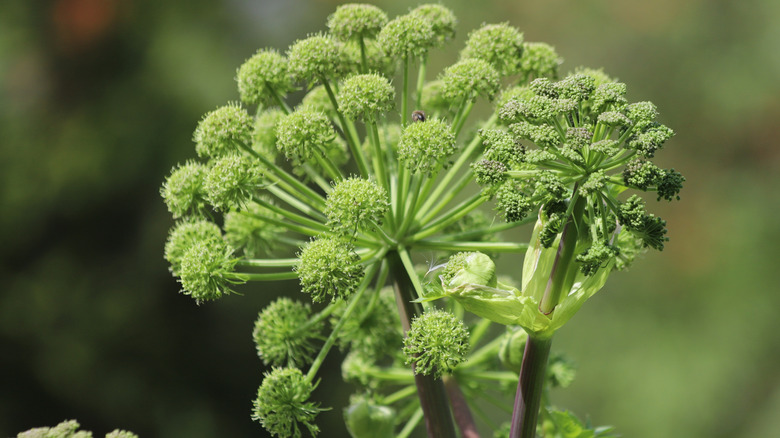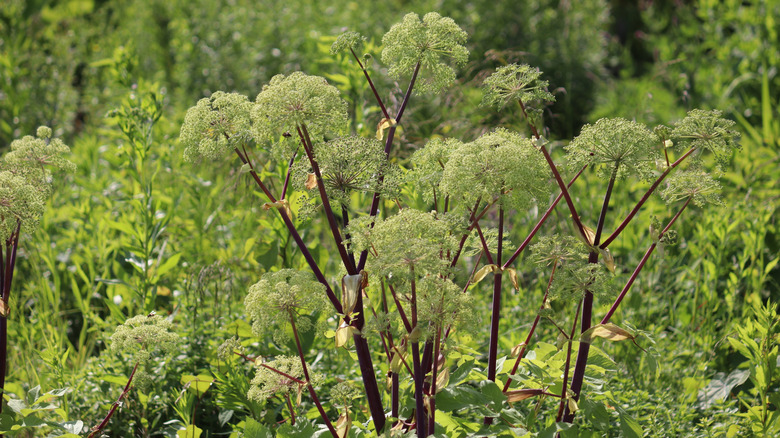
O2o Creative/Getty Images
When you hear that a plant’s name comes from the word “angel,” you might think of something delicate and fragile, or a type of plant that needs constant care. But garden angelica (Angelica archangelica) is surprisingly hardy. This herb earns its name not just from its purported divine healing properties, but also from its ability to reliably return to the garden year after year.
A biennial member of the carrot family, garden angelica has yellow-green leaves and is impressively tall, reaching heights of up to 6 feet in its second year. Its dramatic flower stalks are topped with large, umbrella-like clusters of greenish-white flowers that bring visual interest to any outdoor space. Once established, this plant becomes a dependable, low-effort addition to your garden, creating new plants from the seeds it scatters without any extra help. Though it’s a generous self-seeder, it’s also an herb that can be propagated by cuttings. With a little initial care, angelica will become a self-sufficient grower in your garden for years to come.
Garden angelica lifecycle and growing conditions

Kabar/Shutterstock
Garden angelica is a biennial plant, meaning its lifecycle spans two years. During its first year, the plant develops a strong root system and lush, compound leaves. While this initial growth requires some attention, the plant’s true magic happens in its second season. It sends up a towering, hollow stem topped with those impressive flower clusters that attract helpful pollinators. After the seeds ripen at the end of the second summer, the plant finishes its lifecycle and freely scatters its seeds, creating a new generation of plants.
In the U.S., garden angelica is hardy in USDA zones 5 through 7. In its native range in Europe, this plant often found near streams or wet meadows, and it has a preference for damp conditions. To keep the plant thriving, make sure it’s in a partly shaded area with consistently moist soil. Its penchant for moisture also makes garden angelica an excellent choice for growing alongside other plants that thrive in soggy soil. Though its leaves and stems have a unique licorice flavor and are used in both sweet and savory dishes, it’s the plant’s self-sufficient nature that really makes it an outstanding addition to the garden.
Angelica pests, diseases, and spread control

Kazakov Maksim/Shutterstock
Once your angelica plant is established, you’ll find that it’s low maintenance and generally easy to grow. However, like many plants, it’s susceptible to common pests and diseases. For example, aphids may occasionally appear on the leaves and stems. A strong blast of water from a hose is often enough to dislodge them, but a gentle application of insecticidal soap can be used for more stubborn infestations. You’ll also want to watch out for slugs and snails, which are known to munch on the foliage. These pests can be managed with organic deterrents, simple traps, or common kitchen ingredients. Fungal diseases, such as powdery mildew, can sometimes affect garden angelicas, particularly in areas with poor air circulation. To prevent this, make sure the angelica isn’t too crowded by other plants.
The primary concern for angelica isn’t about constant watering or fertilizing, it’s about managing its self-seeding. This plant is effective at reproducing, and if left unchecked, it will happily create multiple plants all on its own. To keep the growth contained, simply pull out any unwanted new seedlings that sprout up. For a more proactive approach to controlling your angelicas’ spread, remove some of the flower heads after they’ve finished blooming but before they have a chance to drop their seeds.


Comments are closed.